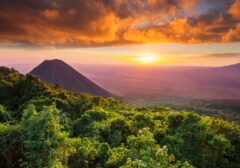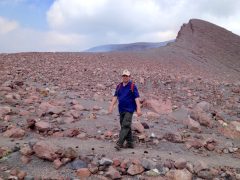Private Journeys
Undiscovered Nicaragua and El Salvador
19 days from £4,650pp
(based on two people sharing & excluding flights)
Essentials
-
Tour info
-
Country info
-
What's included
Tour info
Transport
8 road journeys; 5 river and lake boat journeys; 1 flight (Managua – San Salvador)
Accommodation
In general you will be staying in small, mid-range hotels with reasonable facilities. Some are family run and offer a friendly and homely welcome. The range of properties is such however that you stay in all of a restored convent, colonial house, a coffee estate and beachside cabins.
Meals
Breakfast daily, lunch days 2, 15; full board days 3,4.
Guides
We carefully select our local partners, some of whom we have worked with for over 25 years. Their English-speaking guides understand the expectations of our clients very well, and are consistently singled out for praise by the latter on their return.
Summary Of Nights
19 days, 18 nights: Granada 2; El Castillo 2; Ometepe 3; León 2; Perquín 2; Suchitoto 2; Ataco 2; Costa del Sol 3.
Currency
The unit of currency in Nicaragua is the córdoba, in El Salvador the US dollar.
How To Take It
Cash machines are available in Managua airport, and in Granada and León: taking a debit or credit card with a PIN number is the most convenient way of withdrawing money while on your trip and in the more upmarket shops and restaurants you can also pay by card. However, since cards can get lost, damaged, withheld or blocked, or the phone line to the bank may be down, you should not rely exclusively on a card to access funds. You should authorise your bank first, and withdrawals may be limited.
In el Salvador you can obtain US dollar cash with a card in banks and may be able to obtain cash advances via the few ATMs in larger towns. Tourist-focused services in Nicaragua also accept US dollars cash while small outlets will charge in córdobas.
We recommend that you take a reasonable quantity of dollar notes (no more than is covered by your insurance). Dollar bills should be in good condition, soiled or torn bills may be refused.
Daily Spend
It is very difficult to give a guideline for essential expenses but a budget of around US$35 per day should cover the cost of meals not included in the holiday price, drinks and the odd souvenir. Eat at the best restaurants and you will pay considerably more.
Tipping
Tips are welcomed and local guides often rely on their tip as a significant proportion of their income.
Most service industry workers will expect a tip of some kind and so it is useful to have spare change for hotel porters, taxi drivers and the like. It is common to leave 10 – 12% in restaurants.
Tipping guidelines can be found in our Briefing Dossier.
Insurance
Travel insurance is essential. Details of our recommended policy can be found on our Travel Insurance page.
Airport Taxes
If you have purchased your flights through Journey Latin America, the international departure tax is usually included in the ticket.
Visas
From 15 August 2024, UK passport holders require a visa for Honduras, a country which is transited by road during this holiday. Full UK passport holders do not need a visa for the other countries visited on this holiday (see below if travelling via the USA). Anyone with a different nationality should enquire with us or check with the relevant consulate.
If flying to the US, or via the US you will need to fill in your online ESTA application.
Trip Suitability
Generally this holiday is suitable for all able, reasonably fit travellers who accept the sometimes uncertain and rudimentary nature of travel to remote places. There are a few days where you spend most of the time travelling.
If you have a disability which we should be aware of, please contact us.
Climate
This itinerary takes you to tropical climes where the sun is strong and temperatures high – often over 30°C. Those travelling between May and October should encounter higher temperatures (around 35°C) and high humidity. The ‘official’ rainy season is May to October.
Clothing And Special Equipment
Bring plenty of light cotton clothing and good, comfortable walking shoes. A waterproof jacket is also necessary. We suggest that you plan to ‘layer’ your clothing; it is easier and more efficient to put on a couple of light layers than one thick jumper, and sensible to have long sleeves for areas where mosquitos may be lurking. Sandals are a good informal option for evenings. Protection against the sun (sunblock, sun hat) and mosquito repellent are essential and you should bring swimwear. A daypack is useful for carrying sunblock, guidebook, water and any extra layers.
Please note Nicaragua prohibits certain items, including binoculars with night vision capability. Whilst it’s our understanding that you can bring a pair of normal binoculars into the country, some travellers have experienced delays upon entry whilst these are checked by customs.
Vaccinations
Preventative vaccinations are recommended against the following; typhoid; polio; tetanus; hepatitis A. For specific requirements you must consult your GP.
You can also find helpful information on the Masta Travel Health website.
Country info
When is the best time to visit Nicaragua?
Situated well within the tropics, Nicaragua has a typical tropical climate with high temperatures all year round at low altitudes. Temperatures are significantly modified by altitude – higher up it can be very cool at night. May-Nov is rainy season, but places on the eastern coast, the Caribbean side, tend to be rather wetter, and to have a longer rainy season, than those on the Pacific coast to the west. There’s a risk of tropical storms or hurricanes Jun-Nov.
What is the official language of Nicaragua?
The official language of Nicaragua is Spanish.
What is the official currency of Nicaragua?
The official currency of Nicaragua is the Córdoba. Notes can be obtained from exchange houses and also from banks which will supply advances on a debit or credit card. There are ATMs in large towns where you can use a UK credit or debit card. You may have to ask your bank to authorise withdrawals before you leave UK, and amounts may be limited. ATMs allow you to choose between dollar or córdoba notes but the latter come in large denominations – try to break them down when you can. There are few ATMs outside of the main cities: bring cash with you for rural areas.
What is the time difference between the UK and Nicaragua?
The time difference between the UK and Nicaragua is GMT-6 hours.
Do I need a visa for Nicaragua?
Holders of a full British passport do not require a visa, although passports must be valid for at least 6 months after the trip begins. Anyone with a different nationality should enquire with us or check with the relevant consulate.
If flying to the US, or via the US you will need to fill in your online ESTA application.
What vaccinations do I need for Nicaragua?
Please check Travel Health Pro for information on health recommendations and vaccinations for the destinations you are visiting. Please note that many Latin American countries require proof of vaccination against Yellow Fever if you have recently travelled to another country where Yellow Fever is present.
What countries does Nicaragua combine well with?
A visit to neighbouring Central America countries, such as tiny, friendly El Salvador and wildlife-rich, slickly organised Costa Rica.
What are the festivals, cultural and sporting events in Nicaragua?
Semana Santa, (Easter, throughout Nicaragua). Processions inspired by biblical stories. Popular traditions include “the donkey procession,” on Palm Sunday; a procession of pilgrim carts that come from all parts of Nicaragua and gather in Granada; San Lázaro’s pet dog blessing in Masaya; and San Juan del Sur’s beach party celebration.
Fiestas de Masaya, Masaya, end of Sep for 3 months. A celebration on Sundays of parades and tamarindo music. It includes the Fiesta del Toro and Fiesta de los Aguisotes in late Oct and ends with the Procesión de San Jerónimo on the first Sunday of Dec.
International Poetry Festival, Granada, second week of Feb annually. Over 150 poets from all parts of the world congregate at this week-long event to recite their best poetry.
When is the best time to visit El Salvador?
The coastal lowlands have a hot tropical climate all year round with temperatures peaking at well over 30°C. The mountainous interior has a milder climate and in Dec-Jan temperatures hover around 18°C and it is cool at night. The best time to visit is during the drier months of Nov-Feb – it gets very hot thereafter. The rainy season runs May-Oct with short tropical showers – it is cooler, but some of the back roads may be impassable. Sep-Nov is the season when rainfall may be heavy and hurricanes are possible.
For more detailed information visit our When To Go section.
What is the official language of El Salvador?
The official language spoken in El Salvador is Spanish.
What is El Salvador's official currency?
The official currency of El Salvador is the US dollar. The former local currency (colon), was phased out in 2003. You can obtain US dollar cash or exchange travellers cheques locally in banks and money exchanges (casas de cambio) and may be able to obtain cash advances via the few ATMs in larger towns and cities. You should authorise your bank first, and withdrawals may be limited.
What is the time difference between El Salvador and the UK?
The time difference between the UK and El Salvador is GMT-6 hrs.
Do I need a visa for El Salvador?
Holders of a full British passport do not require a visa, although passports must be valid for at least 6 months after the trip begins. Anyone with a different nationality should enquire with us or check with the relevant consulate.
If flying to the US, or via the US you will need to fill in your online ESTA application.
What vaccinations do I need for El Salvador?
Please check Travel Health Pro for information on health recommendations and vaccinations for the destinations you are visiting. Please note that many Latin American countries require proof of vaccination against Yellow Fever if you have recently travelled to another country where Yellow Fever is present.
Which other countries combine well with El Salvador?
A visit to neighbouring Central America countries, such as Nicaragua with its splendid colonial cities and coral island beaches; wildlife-rich, slickly organised Costa Rica and the Mayan cities of Guatemala, all easily accessed by land or air.
What are the festivals and cultural or sporting events in El Salvador?
Semana Santa, Easter is celebrated throughout El Salvador. It is celebrated from Thursday through to Easter Sunday.
Towns and villages all celebrate the feast days of their local saint, sometimes with protracted celebrations, as in San Miguel and Sonsonate with programmes of artistic events.
Arts and Culture Festival takes place in February in Suchitoto. The pretty colonial town hosts a world-class arts and culture festival with music and dance groups.
Inspired by this trip
Our exciting range of articles on Latin America explore everything from iconic destinations and lesser-known cultural gems to delicious traditional recipes. You’ll also find exclusive travel tips, first-hand client reviews and the chance to get your personal questions answered by our travel experts.
Papagaio
Your edit for Latin American inspiration
Our exciting range of articles on Latin America explore everything from iconic destinations and lesser-known cultural gems to delicious traditional recipes. You’ll also find exclusive travel tips, first-hand client reviews and the chance to get your personal questions answered by our travel experts.
View Extraordinary Inspiration






































